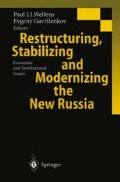Abstract
The August 1998 debt crisis revealed the fragility of the Russian transformation process. In particular, it showed that the budget squeeze is one of Russia’s major problems. In fact, in 1998 the total federal budget in Russia (in dollar terms) has shrunk in magnitude to the government budget of the Irish Republic.
Access this chapter
Tax calculation will be finalised at checkout
Purchases are for personal use only
Preview
Unable to display preview. Download preview PDF.
References
Aizenman, J. and Isard, P. (1996), The Sustainability of Economic Transformation, The Journal of Policy Reform, Vol. 1, 413–440.
Cagan, P. (1956), The Monetary Dynamics of Hyperinflations, in Friedman, M., ed., Studies in the Quantity Theory of Money, Chicago: University of Chicago Press.
Christiano, L. J. (1987), Cagan’s Model of Hyperinflation under Rational Expectations, International Economic Review, Vol. 28, 33–49.
Cukierman, A. (1992), Central Bank Strategy, Credibility, and Independence: Theory and Evidence, Cambridge, Mass.: MIT Press.
Devreux, M. B. and WEN, J.-F. (1998), Political Instability, Capital Taxation, and Growth, European Economic Review, Vol. 42, 1635–1651.
DIW (1998), Die wirtschaftliche Lage Rußlands — Krise offenbart Fehler der Wirtschaftspolitik, Deutsches Institut fur Wirtschaftsforschung, Wochenbericht 51–52/98, Berlin: Duncker & Humblot.
Ferreira, P. C. (1999), Inflationary Financing of Public Investment and Economic Growth, Journal of Economic Dynamics and Control, Vol. 23, 539–563.
Hayashi, F. and Matsui, A. (1996), A Model of Fiat Money and Barter, Journal of Economic Theory, Vol. 68, 111–132.
IMF (1998), World Economic Outlook, October 1998, World Economic Financial Surveys, International Monetary Fund, Washington, D.C.
Miller, P. J. (1999), The Jointly Optimal Inflation Tax, Income Tax Structure, and Transfers, Staff Report, Number 193, Research Department, Federal Reserve Bank of Minneapolis.
Mondino, G., Sturzenegger, F., and Tommasi, M. (1998), Recurrent High Inflation and Stabilization: A Dynamic Game, in Sturzenegger, Federico and Tommasi, Mariano, The Political Economy of Reform, Cambridge, Mass., MIT Press.
Morrien, H.-H. (1996), Wahrungssubstitution und Wahrungswettbewerb — Eine marktgetriebene Wahrungsreform far RuBland, Bochumer Schriften zur Entwicklungsforschung und Entwicklungspolitik, Band 38, Ginter Olzog Verlag.
Mundell, R.A. (1965), Growth, Stability and Inflationary Finance, Journal of Political Economy, Vol. 73, 97–109.
Persson, T. and Svensson, L. E. O. (1989), Why a Stubborn Conservative Would Run a Deficit: Policy with Time-consistent Preferences, Quarterly Journal of Economics, Vol. 104, 325–346.
Persson, T. and Tabellini, G. (1990), Macroeconomic Policy, Credibility and Politics, Paris: harwood academic publishers.
Phelps, E. S. (1968), Money Wage Dynamics and Labor Market Equilibrium, Journal of Political Economy, Vol. 76, 687–711.
Phelps, E. S. (1973): Inflation in the Theory of Public Finance, Swedish Journal of Economics, Vol. 75, 67–82.
Poser, J. A. (1997), Modelling Barter and Demonetisation in FSU Economies, Discussion Papers, No. 42, IFO Institute for Economic Research, Munich.
Sargent, T. J. (1977), The Demand for Money during Hyperinflations under Rational Expectations, International Economic Review, Vol. 18, 59–82.
Tabellini, G. and Alesina, A. (1990), Voting on the Budget Deficit, American Economic Review, Vol. 80, 37–49.
Tornell, A. and Lane, P. R. (1999), The Voracity Effect, American Economic Review, Vol. 89, 22–46
Welfens, P. J. J. (1998), The Russian Transformation Crisis: Origins, Analysis and Policy Requirements, paper presented at an IMF seminar, Washington, D.C., November 1998, revised December 1998.
Editor information
Editors and Affiliations
Rights and permissions
Copyright information
© 2000 Springer-Verlag Berlin Heidelberg
About this chapter
Cite this chapter
Bohn, F. (2000). The Rationale for Seigniorage in Russia — A Model-Theoretic Approach. In: Welfens, P.J.J., Gavrilenkov, E. (eds) Restructuring, Stabilizing and Modernizing the New Russia. Springer, Berlin, Heidelberg. https://doi.org/10.1007/978-3-642-57257-9_13
Download citation
DOI: https://doi.org/10.1007/978-3-642-57257-9_13
Publisher Name: Springer, Berlin, Heidelberg
Print ISBN: 978-3-642-63156-6
Online ISBN: 978-3-642-57257-9
eBook Packages: Springer Book Archive

